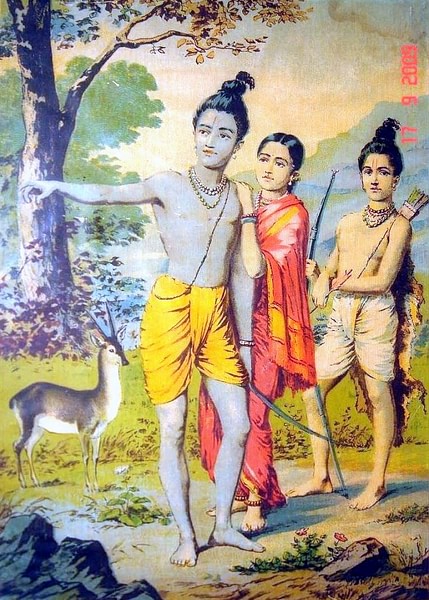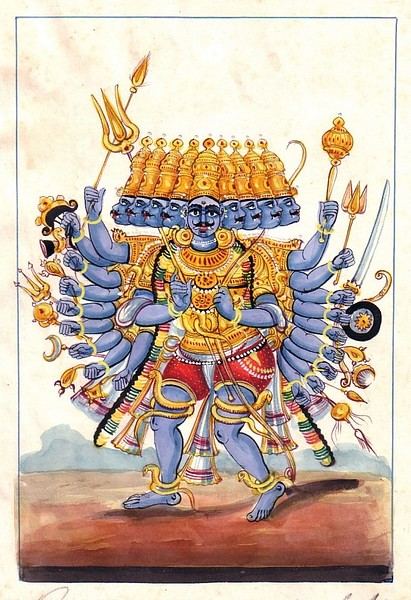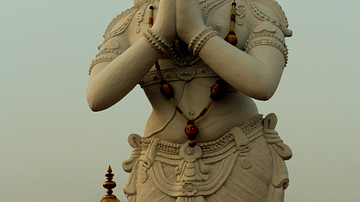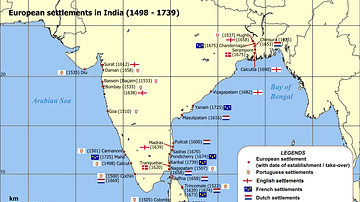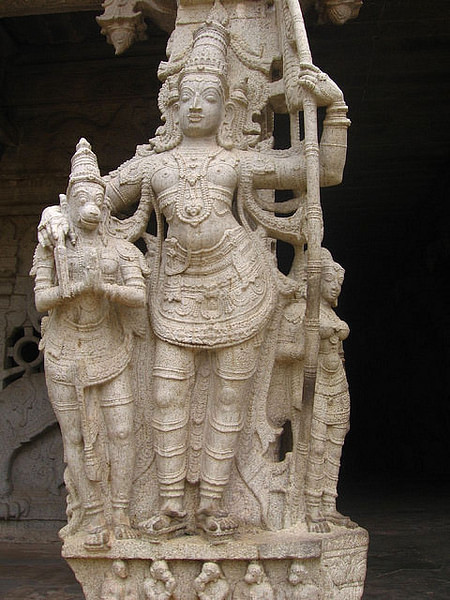
Rama (or Ramacandra) is the seventh avatar of the Hindu god Vishnu. His adventures include the slaying of the demon king Ravana which is recounted in the Vana Parva of the Mahabharata and in the Ramayana, the oldest Sanskrit epic, written sometime in the 5th century BCE but with some later additions.
Lord Rama, considered by many Hindus to be based on an historical figure, is perhaps the most virtuous hero from Hindu mythology and he, along with his wife Sita, are a picture of purity and marital devotion. Further, the adventures of Rama illustrate above all the importance and rewards of fulfilling one's pious duty or dharma.
Rama's Family
Rama's father is King Dasaratha, a prince of the solar race, and his mother is Queen Kausalya. Rama was born at the end of the Second Age or Treta-yuga and he came into the world specifically at the bidding of the gods to deal with the fearsome multi-headed demon Ravana, the king of Lanka (modern Sri Lanka). The great god Vishnu answered the gods' call and appeared in a sacrificial fire made by Dasaratha. The pious king was presented with a pot of nectar, and he gave half of it to Kausalya who produced half-divine Rama as a consequence. Rama had three half-brothers – Bharata, Lakshmana, and Shatrughna - all with some, albeit lesser, divine qualities. Rama's favourite brother and great companion was Laksmana, son of Sumitra, while his loyal servant was the monkey warrior Hanuman (or Hanumat).
Rama Meets Sita
Rama's first adventure occurred when the sage Visvamitra asked for help in fighting a demon or raksasa. Rama and Laksmana, leaving their childhood home at Ayodhya capital of the northern kingdom of Koshala, followed Visvamitra to his home and there killed Taraka, a terrible female demon. In gratitude Rama was given divine weapons, and he set off for more adventures, ending up in Mithila. There Janaka the king of Videha hosted our hero, and he met the king's beautiful daughter Sita (also called Janaki or Maithili). The king had promised the princess in marriage to anyone who could manage to bend a huge bow which had once been the weapon of the great god Shiva. Rama, with his divine strength, did more than just bend the bow but broke it in half and so won the hand of Sita, his first and most revered wife.
Rama's Exile
Rama's succession to the throne of Ayodhya was made difficult by his mother's hunchback slave Manthara. Jealous of Rama, she soured the opinion of Kaikeyi, Dasaratha's second wife, and convinced her to persuade her husband to instead make Bharata heir to the throne. On top of this slight Rama was exiled from the kingdom for fourteen years. So, accompanied by Sita and his ever faithful companion Laksmana, Rama went to live in the far south in Citrakuta, deep in the Dandaka forest. Meanwhile, Dasaratha died, but Bharata, seeing the injustice of Rama's treatment, decided not to become king but instead to search for and return Rama to his rightful home and birthright. When the two brothers met once again, Rama obstinately refused to return to Ayodhya until he had fulfilled his father's wishes and served out his fourteen years of exile. After much discussion, Bharata agreed to act as regent until that time, and to prove to his subjects Rama's decision, he took his brother's shoes as a symbol of Rama's royal status.
Rama & Ravana Clash
Rama did not stay still in the remainder of his exile but visited many sages. Eventually, he ended up at Pancavati along the river Godavari, an area plagued by demons. One in particular, Surpanakha, the sister of Ravana, fell in love with Rama, and when her advances were resisted, she attacked Sita in revenge. Laksmana was the first to react and cut off the ears and nose of Surpanakha. Not best pleased with this treatment, the enraged demoness gathered an army of demons to attack the trio. In an epic battle Rama defeated them all; however, Surpanakha was not finished with the matter and she persuaded Ravana that Sita was a girl worth fighting for. Accordingly, the demon king sought out Rama's home, and while Rama was distracted in the hunt for a deer (who was actually Ravana's magician Maricha in disguise), abducted Sita, taking her back to Lanka in his aerial chariot to be kept captive in his beautiful Ashoka garden.
Rama followed in hot pursuit but met several troublesome distractions along the way. The first was the headless monster Kabandha. Killing the creature, its departing soul proved more helpful and advised Rama that before confronting Ravana, our hero should enlist the help of Sugriva, king of the monkeys. Finding on their arrival at Sugriva's capital Kiskindha that the king had lost his throne to his brother Balin, Rama helped restore Sugriva to power. A grateful Sugriva gave Rama use of an army and enlisted the help of Hanuman, who besides being an able general was the son of the wind and able to leap huge distances and take any form he wished. It was he who magically transported Rama and his force to Lanka, crossing the rock bridge built by the skilled general Nala, son of Visvakarma, which became known as Rama's Bridge.
A series of titanic battles between Rama's forces and the demons followed, but eventually Ravana was slain, Lanka fell to Rama's army, and our hero was reunited with his wife. Rama was not entirely convinced that his wife had remained loyal to him during her abduction, but Sita determined to prove her honour by a test of fire, indeed the divine fire of Agni, no less. Escaping the flames unscathed, Rama realized he had misjudged Sita, and the couple headed back for Ayodhya where Rama reclaimed his throne and began a golden era of government.
According to the Uttara Kanda the story continues with Rama still harbouring suspicions about his wife's virtue during her captivity with Ravana. Rama thus exiles Sita to live with the sage Valmiki, and it is there that she bears him twin sons, Kusa and Lava. Eventually the sons return to Ayodhya where Rama recognizes his offspring and, in a fit of remorse, recalls the wronged Sita. In the Ramayana everyone lives happily ever after at this point, but in the Uttara Kanda the tale is not quite finished. Still proclaiming her innocence, Sita now swears her virtue on the earth itself which then promptly swallows her by opening beneath her feet. Rama, now even more distraught, vows to follow his wife to heaven, but Time appears to him in the guise of an ascetic and calls for him to remain and fulfil his duty on earth. Nevertheless, Rama wades into the river Sarayu and from there is welcomed into heaven by Brahma.
Worship & Representation in Art
Rama remains a figure of worship across India and South-east Asia but especially in Oude and Bihar. He has, for example, a magnificent temple at Ramesvaram, notable for its 17th century CE columned corridor. In addition, the Ramanandis are the largest and perhaps strictest Vaishnava monastic order. Rama is also considered by some Buddhists to be an avatar of Buddha, and sculptures of the hero sometimes appears on the exterior of Buddhist temples.
In art Rama is always youthful and typically has green or blue skin, holds a bow and arrows, and wears a yellow robe. He is most often seen with Sita, Laksmana, and Hanuman – collectively known as Rama's family or Rama Parivara. Episodes from the Ramayana are especially popular in Hindu sculpture, wall paintings, and art in general, most of all forest scenes with Rama hunting the deer and the epic battle with Ravana.
